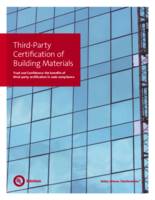
Third-Party Certification of Building Materials eBook
Understand the nuances of self-declaration and third-party services, including the different ways to demonstrate that products comply with standards and code requirements.

Code officials, architects, specifiers, plan reviewers and other code authorities have the important responsibility of determining whether building products and assemblies comply with governing codes and regulations. While this may sound straightforward, many questions arise pertaining to such a determination:
This overview addresses these commonly asked questions and explains the important role that third-party certification plays in demonstrating code compliance for all stakeholders.
In this eBook, you will learn about the following topics:

Third-Party Certification of Building Materials eBook